Wood Products Deterioration

Early stages of white rot caused this wood to turn white. This is a board cut from a harvested urban tree killed by the emerald ash borer and sold by 'Wood from the Hood'. Fungi come in quickly after beetle attack. This tree had early stages of white rot. Strength losses from white rot are not excessive until later stages of decay.
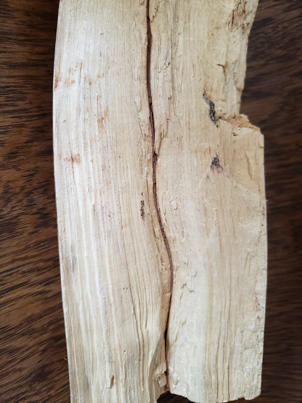
Advanced stages of white rot showing the bleached white color of the wood.
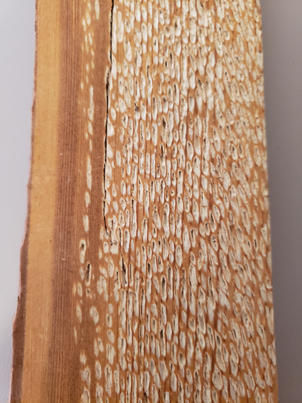
Some white rot fungi are more selective at degrading lignin than others. This is a white pocket rot in pine where the fungus removed all of the lignin in localized pockets leaving cellulose behind.

White pocket rot in oak showing interesting patterns of delignified wood and non-decayed wood.
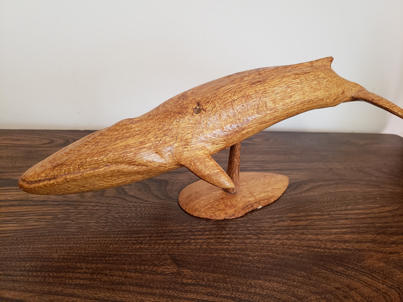
White pocket rots also do not cause large strength losses until advanced stages. This is a whale carving was made from oak with white pocket rot.

Soft-rot in wood. These fungi attack wood in extreme environments - such as very wet or very dry conditions. This wood came from a waterlogged environment. Soft rot can look something like brown rot but it is very different with cavities formed in the wood cells (see lecture video for more information).

Another example of soft rot. This wood is a section of a timber from a a Pueblo dwelling in Chaco Canyon, a dry desert site in New Mexico (studied in collaboration with the US National Park Service).

Example of soft rot from the lab. This is a very old brush that was placed in a holder after each use. Since water drained into the holder and kept the wood wet, the end of the brush was degraded by a soft rot fungus which slowly decayed and reduced the size of the brush handle.
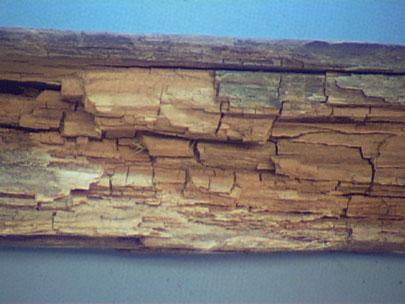
Brown rot fungi cause a diffuse attack of cellulose resulting in large strength losses early in the decay process.
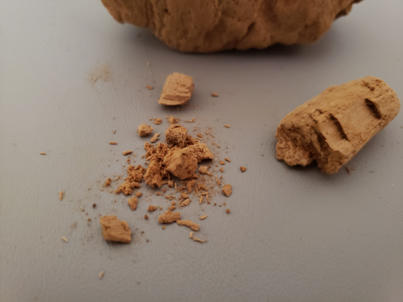
Advanced stage of brown rot showing how it can disintegrate into fragments with just slight pressure.

Brown rot in timber at site of moisture accumulation. This was a wooden stadium bleacher

Brown rot from an old building on 7th Street in St Paul, MN (built in the 1800's) causing extensive damage to the wooden timbers in the building.
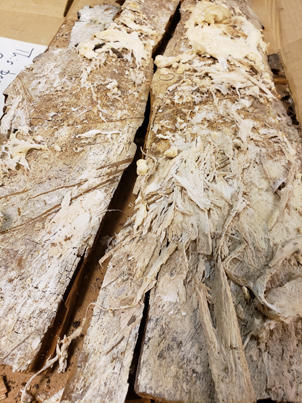
The brown rot fungus produced mycelial fans and white rhizomorphs that grew throughout the building.

White rhizomorphs produced by Serpula lacrymans, a brown rot fungus that attacked wood in buildings. Rhizomorphs are used by the fungus to transport nutrients and water long distances.

The Fruiting body of Serpula lacrymans.

White rhizomorphs (left) and fruiting body (right) of Meruliporia incrassata, another brown rot fungus that frequently is found in buildings.

Wooden shingles decayed by the brown rot fungus Gloeophyllum trabeum.

Fruiting bodies of Gloeophyllum trabeum.

Redwood has excellent decay resistance but wood from young 2nd growth trees does not. Here is a redwood timber that decayed in just a few years being outside.

To protect wood for outside applications, non-decay resistant wood like pine is impregnated with various preservatives. Left photo shows a timber with heartwood and sapwood. Less preservative penetrates the heartwood. This area is often the first to be degraded (right photo) since it has less preservative in it.

Carpenter ant damage in wood. Carpenter ants move into wood with decay. If you have carpenter ants causing damage you very likely had decay present in the wood first that attracted the ants.